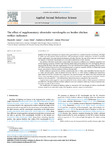The effect of supplementary ultraviolet wavelengths on broiler chicken welfare indicators
| dc.contributor.author | James, C | |
| dc.contributor.author | Asher, L | |
| dc.contributor.author | Herborn, Katherine | |
| dc.contributor.author | Wiseman, J | |
| dc.date.accessioned | 2019-01-22T09:34:22Z | |
| dc.date.available | 2019-01-22T09:34:22Z | |
| dc.date.issued | 2018-12-01 | |
| dc.identifier.issn | 0168-1591 | |
| dc.identifier.issn | 1872-9045 | |
| dc.identifier.uri | http://hdl.handle.net/10026.1/13203 | |
| dc.description.abstract |
© 2018 The Authors Qualities of the light environment are important for good welfare in a number of species. In chickens, UVA light is visible and may facilitate flock interactions. UVB wavelengths promote endogenous vitamin D synthesis, which could support the rapid skeletal development of broiler chickens. The aim of the study was to investigate the impacts of Ultraviolet wavelengths (UV) on welfare indicators in broiler chickens. Day-old Ross 308 birds reared under commercially representative conditions were randomly assigned to one of three lighting treatments: A) White Light Emitting Diode (LED) and supplementary UVA LED lighting (18-hour photoperiod); B) White LED with supplementary UVA and UVB fluorescent lighting providing 30 micro watts/cm2 UVB at bird level (on for 8 h of the total photoperiod to avoid over-exposure of UVB); C) White LED control group, representative of farm conditions (18-hour photoperiod). Welfare indicators measured were; feather condition (day 24, n = 546), tonic immobility duration (day 29, n = 302), and gait quality, using the Bristol Gait Score (day 31, n = 293). Feather condition was improved in male broilers in the UVA treatment (A), compared to the control treatment (C). Birds in the UVA treatment had shorter tonic immobility durations compared to the control treatment (C), suggesting lower fearfulness. Broilers reared in UVA (A) and UVA + UVB (B) had better Bristol Gait Scores compared to the control (C). Together these results suggest UV may be beneficial for broiler chicken welfare. While treatment A and B both provided UVA, the improvements in welfare indicators were not consistent, which may be due to exposure time-dependent beneficial effects of UVA. The modification of commercial lighting regimes to incorporate UVA wavelengths for indoor-reared broiler chickens would be an achievable change with significant positive impacts on bird welfare. | |
| dc.format.extent | 55-64 | |
| dc.format.medium | ||
| dc.language | en | |
| dc.language.iso | en | |
| dc.publisher | Elsevier | |
| dc.subject | Broiler chicken | |
| dc.subject | Poultry welfare | |
| dc.subject | Husbandry | |
| dc.subject | Lighting | |
| dc.subject | Ultraviolet light | |
| dc.title | The effect of supplementary ultraviolet wavelengths on broiler chicken welfare indicators | |
| dc.type | journal-article | |
| dc.type | Journal Article | |
| plymouth.author-url | https://www.webofscience.com/api/gateway?GWVersion=2&SrcApp=PARTNER_APP&SrcAuth=LinksAMR&KeyUT=WOS:000450383800009&DestLinkType=FullRecord&DestApp=ALL_WOS&UsrCustomerID=11bb513d99f797142bcfeffcc58ea008 | |
| plymouth.volume | 209 | |
| plymouth.publication-status | Published | |
| plymouth.journal | Applied Animal Behaviour Science | |
| dc.identifier.doi | 10.1016/j.applanim.2018.10.002 | |
| plymouth.organisational-group | /Plymouth | |
| plymouth.organisational-group | /Plymouth/Faculty of Science and Engineering | |
| plymouth.organisational-group | /Plymouth/Faculty of Science and Engineering/School of Biological and Marine Sciences | |
| plymouth.organisational-group | /Plymouth/REF 2021 Researchers by UoA | |
| plymouth.organisational-group | /Plymouth/REF 2021 Researchers by UoA/UoA04 Psychology, Psychiatry and Neuroscience | |
| plymouth.organisational-group | /Plymouth/Users by role | |
| plymouth.organisational-group | /Plymouth/Users by role/Academics | |
| dc.publisher.place | Netherlands | |
| dcterms.dateAccepted | 2018-10-01 | |
| dc.rights.embargodate | 2019-11-27 | |
| dc.identifier.eissn | 1872-9045 | |
| dc.rights.embargoperiod | Not known | |
| rioxxterms.versionofrecord | 10.1016/j.applanim.2018.10.002 | |
| rioxxterms.licenseref.uri | http://www.rioxx.net/licenses/all-rights-reserved | |
| rioxxterms.licenseref.startdate | 2018-12-01 | |
| rioxxterms.type | Journal Article/Review |


